30 of the Creepiest and Most Haunted Places in Greece

Salem Mansion Thessaloniki
Photo used as a poster for hit American TV Show, American Horror Story’
Photo by Alexander Hadji
Each year thousands of visitors travel to Greece, they flock to all the usual tourist attractions.
They sun themselves on the golden beaches and swim in the warm, turquoise waters, totally unaware, that nearby, there may be some of the creepiest places in all of Greece!
It’s no surprise that Greece, with so many ruins and relics, has lots of ghostly stories about hauntings, unexplained phenomena andspooky abandoned places, most of them not widely known.
Below, in six sub-sections, I have listed thirty of the most mysterious and unusual, places in Greece.
Some are scary, some quirky, some unexplained, some are sad but all of them are fascinating!
Ancient and not so Ancient Anomalies
1. Daveli’s Cave:
Mount Parnitha, Athens
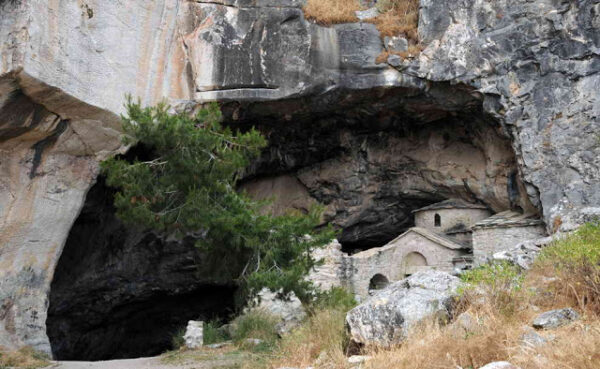
Davelis cave – Mount Penteli Athens Greece
A cave, discovered in the fifth century BC, on Mount Penteli, named Daveli, after a thief (His real name was Christos Natsios) who used it as a hideout and a place to stash his ill-gotten gains, is one of the most mysterious places in Athens.
Daveli’s Cave, once used as a marble quarry for the Acropolis, is said to have been used as a place of worship for the followers of the satyr Pan and his nymphs.
In the middle Ages, Christian hermits built a church at the entrance to the cave, dedicated to two Saints; Saint and Saint Nicholas.
Strange goings on occurred in 1977, when construction began at the cave but what was being built and who was doing the building remains a mystery.
Was it the Greek government?
It’s rumoured that the construction work in and around Daveli’s Cave, may have been storage for nuclear weapons, or a site for radar or a communications base.
The site is said to be used today by Satanists and occultists.
Actually, since ancient times, the area has been associated with paranormal activity, such as water running uphill instead of down, electronics going crazy and apparitions of a cat-like creature, walking on two legs are also said to have been spotted.
2. The Frangokastello Fortress and the Drousoulites:
Crete

Frangokastello Photo by CBrug
A few kilometres East of Sfakia, on the island of Crete, in around 1373, the then rulers, the Venetians, built a garrison to keep the unruly locals in check.
They named the garrison; The Castle of Nikitas, after a nearby church, the Sfakians named it Frangokastello, Castle of Catholic Foreigners.
Every spring, on the 17 of May, the anniversary of the Battle of Frangokastello 1828, during the Greek war of Independence, early in the morning, locals report seeing ghosts of soldiers, dressed in black, some walking, some on horseback, slowly making their way towards the castle.
These ghosts are The Drosoulites, The Dew Men, so called because they arrive when the dew is still fresh.
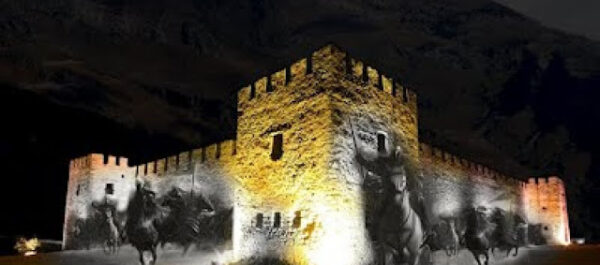
Frangokastelli Drosoulites – photo from Kriti Online
The Drosoulites are said to be the ghosts of Hadzi Michalis Dalanis and his men, who defended the castle against the Turks and whose bodies remained unburied, until a strong wind brought sand from the Orthi Ammos Beach to cover them.
3. The Necromanteion of Acheron:
Ephyra, Epirus

Necromanteion of Ephyra. The Oracle of the Dead.
On the banks of the River Acheron, near Ephyra, at the point where three of the five rivers of the underworld meet, sometime around the third or fourth century BC, was built a temple, dedicated to the god and goddess of the underworld; Hades and Persephone.
This was a temple of necromancy, said to be the entrance to Hades, the Underworld, which, once their bodies had decayed in the earth, and their spirits released, was the final resting place of the dead.
Ceremonies held at the temple, involved eating special food, such as beans, pork and barley bread, narcotic potions were ingested or inhaled and sheep were sacrificed, all in the belief that this would greatly help attempts to contact and converse with dead spirits.

The Necromanteion of Acheron Photo by Mapio net.
Thousands of years after the destruction of the temple (167 BC), a monastery, dedicated to Saint John The Baptist, was built on the site.
Many ancient temples throughout Europe practised necromancy but The Necromanteion of Acheron, Ephyra in Greece was the most famous.
4. The Heptapyrgion Fortress (Yedi Kule):
Thessaloniki

Heptapyrgion (Yedi Kule) Thessaloniki Photo by Joel Cusumano for Atlas Obscura
Heptapyrgion, in Greek, and Yedi Kule, its old Turkish name, mean seven towers, despite this, the fortress of Thessaloniki, which became an infamous prison, has ten towers.
Originally part of the fourth century city walls, it became an enclosed castle around the twelfth century and was used as an Ottoman military fortress; it was converted into a prison in the 1890s.
Yedi Kule prison, as it was known, was used to hold political prisoners during the Metaxas Regime of 1936, the Nazi occupation of Greece in WWII, The Greek Civil War, and later, political prisoners during the seven years of dictatorship 1967- 1974.
Yedi Kule was immortalised when referred to in the underground, Greek blues genre of songs; rebetiko.

The Heptapyrgion Fortress (Yedi Kule) Thessaloniki
Ironically, the prison chapel was dedicated to Saint Eleftherios, which means freedom!
The prison closed and moved outside the city in 1989 and now belongs to The Ministry of Culture.
Mostly, people visit the Heptapyrgion Fortress for the spectacular views, few know of the despair of the inmates, the haunting memories of the turbulent times of torture and execution.
Haunted Houses
5. The Longos Mansion or, the Red House:
Thessaloniki
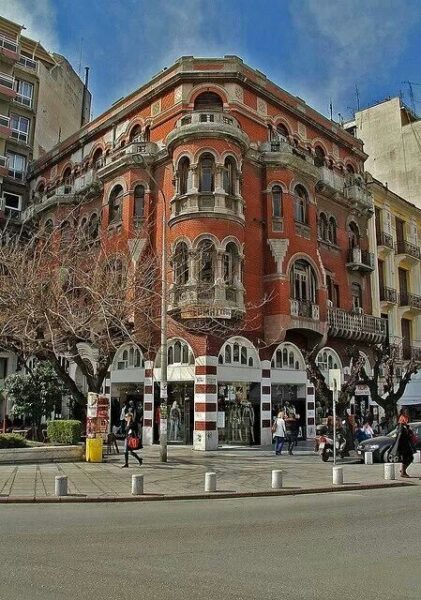
Longos Mansion – The Red House of Thessaloniki
At the corner of Agia Sophia Street and Ermou, stands one of Thessaloniki’s landmarks, The Longos Mansion, also known simply as The Red house, owing to its striking colour.
From the time it was built (1926-1928), designed by architect Leonardo Gennari for wealthy textile industrialist, Giannis Longou, the house has been plagued with bad luck.
No sooner than the house was finished, the construction company which built it unexpectedly went bankrupt and the Longos factory, in Naousa, inexplicably burnt to the ground.
Owing to inheritance issues, The Red House of Thessaloniki remained abandoned for forty years, today; three coffee shops take up the ground floor of the building.
The house is thought to be haunted, ghosts are said to have been seen, and paranormal activity reported.
In 2014 Ivan Savvidis, owner of Greek football team PAOK, bought the property, it’s debatable whether the house has brought Savvidis and his football team good or bad luck!
6. The Villa Kazouli Kifisia:
Athens
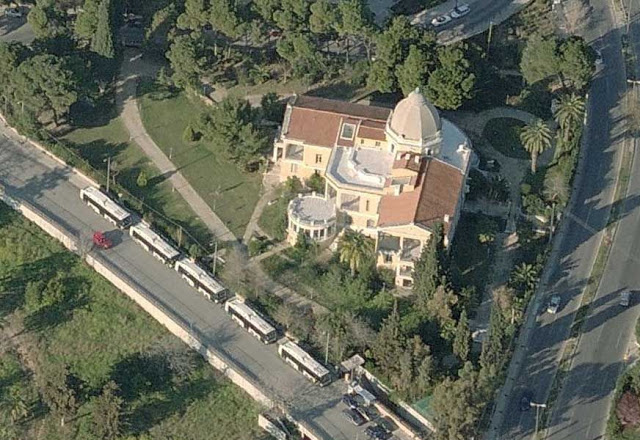
Villa Kazouli Photo Ι.MAVRAKIS & PARTNERS
Villa Kazouli was built on the site of a Turkish cemetery (Mnimouri), at 241 Leoforos Kifisias as a summer residence for Alexandrian business man Nikolas Kazoulis.
During the German occupation of Greece in WWII, Villa Kazouli was used as Nazi headquarters; hundreds of Greeks were imprisoned, tortured and executed there.
Twelve bodies are said to be buried in the grounds.
From 1949 the house was used as a hospital, and in 1953 until 1955, it became a refuge for victims of the devastating Ionian earthquake.
Today, Villa Kazouli houses the National Centre for Environment & Sustainable Development and is a listed, protected building.
The poor tortured souls, victims of unspeakably cruel treatment by the Nazis, sufferers of pain and illness, are said to roam the building and its grounds, their voices crying out for justice and peace.
7. Villa Kallergis Rafina:
Pikermi Attica

Villa Kallergis Rafina-Pikermi Attica
Villa Kallergis, in the Rafina area of Attica, was owned by Pericles Kallergis, who, in 1910, allegedly committed suicide after murdering his wife (Some versions of the story also have him murdering his children).
During WWII, the house was taken over by Nazis who used it to imprison and torture Greeks in the cellar.
Years later, while attempting to demolish the house, a bulldozer suddenly stopped working and after two work men suddenly died from heart attacks, all thoughts of knocking down the house were abandoned.
Local legend tells of a man who accepted a bet from a friend, that he couldn’t last a night in the haunted house, well, he did last the night, but was unable to collect his winnings, he was found dead there the next morning!
It’s said that nothing at all will grow for a few meters around the building, experts who have investigated this peculiar phenomenon, found that the atmosphere surrounding the house is uncommonly high in negative ions, a fact thought to be linked to paranormal activity.
8. Kontos Mansion Ano Lehonia:
Pelion

Kontos Mansion Photo by Eirini Papadaki Flicker
The Kontos Mansion, built in 1900 for Nikolas Kontos, the Russian consul for Greece, who lived there with his wife and four children, is located beside the sea, in the small village of Ano Lehonia, Pelion, on the road to Volos.
Sadly, three of the four children of Nikolas Kontos died from tuberculosis.
During WWII, the Kontos villa, like many other of the elite villas and mansions of Greece, was taken over by Nazis, who used the place to interrogate and torture Greek resistance activists.
Later occupants of Villa Kontos, reported hearing spine-chilling screams and cries and never stayed long, some, who began to renovate the villa, never saw end results as they unexpectedly died before finishing.
Until this day The Villa Kontos stands empty and abandoned.
The Salem Mansion:
Thessaloniki

Salem Mansion Thessaloniki, used as a poster for hit American TV Show; ‘American Horror Story’
Despite its run-down appearance and the name Salem, there’s no creepy ghost story surrounding the Salem mansion, located on Queen Olgas street, Thessaloniki (the image I have used at the top of this post), so I’m not including it in my list of “30 of the creepiest and most haunted places in greece”, I shall, however tell you a bit about it.
The mansion, built by Jeborga , a French Jew and later sold to Jewish lawyer; Emmanuel Salem, in 1894, was eventually sold to the Italian State in 1924 (to which it still belongs) and served as the Italian Consulate until 1978, when it was abandoned after the disastrous earthquake of 1978.
It’s claim to fame came in 2013 when the producers of the television series “American Horror Story,” starring Jessica Lange, used the Salem Mansion as the image on the poster for “Coven”; the third season of the horror anthology.
“Coven” takes place in 2013 in New Orleans and follows a coven of witches descended from Salem as they fight for survival and features flashbacks to the infamous Salem Witch Trials of 1692.
As it was supposedly set in New Orleans, there was no mention of either Thessaloniki or Greece.
Memento Mori
9. The Bogomil Cemetery:
Thessaloniki

Bogomil cemetery at Nea Chalkidona – Photo candiru
In the Medieval graveyard of Agia Eleoussa church at Nea Chalkidona near Thessaloniki, are Celtic-style, Gothic crosses, all that is left of the Bogomils, a Gnostic, heretic sect who survived until the sixteenth century.
The Bogomils, who were found mostly in The Balkans, frequently sent missionaries to Western Europe; it seems some of them must have found their way to Greece.
Fifteen to twenty, tall (some about two metres in height), moss-covered Celtic crosses, and large holes, created by treasure hunters, are all that remain in this all but forgotten, eerie cemetery.
10. The Martyred Villages of Greece:
Distomo – Kalavryta – Kommeno
The German occupation of Greece and her islands, during the Second World War, began in April 1941 and ended in 1945.
Over fourty thousand civilians died from starvation in Athens alone.
The Jewish community of Thessaloniki was all but wiped out, most having been deported to the death camps of Auschwitz and Treblinka.
Industry was destroyed, roads, bridges and railways blown sky high, and as the war progressed, attacks against German soldiers by the Greek resistance, caused the Germans to retaliate by executing thousands of civilians and burning whole villages, leaving millions homeless.
These atrocities happened all over Greece and the Greek islands, far, far too many to mention here, here are details of only three.
Memorials, built to honour and remember the unfortunate victims of the German’s wrath, can be found in every corner of the country.
There is not a village or town in Greece which does not honour the thousands of fallen Greeks, men, women and children, who died at the hands of the Germans during WWII.
Distomo Massacre:
June 10 1944

Distomo Massacre Memorial Greece
The Distomo Massacre was a Nazi war crime carried out by members of the Waffen-SS in the village of Distomo, near Delphi, in Greece, in 1944, during the German occupation of Greece during World War II.
On 10 June 1944, the Waffen-SS troops of the 2nd company, under the command of the 26-year-old Fritz Lautenbach, went door to door and massacred Greek civilians in reprisal for a partisan attack upon the unit’s convoy.
228 men, women and children were executed; according to survivors, SS forces “bayoneted babies in their cribs, stabbed pregnant women, and beheaded the village priest.”

Photo of German troops in the burning village of Distomo found in the pocket of a German solder, held prisoner by ELAS.
The Kalavryta Massacre Peloponnese:
December 13 1943

The Massacre of Kalavryta memoria Photo by Greeker than the Greeks
In early December 1943, the Germans began a mission named “Operation Kalavryta”, intending to encircle Greek Resistance guerilla fighters in the mountainous area surrounding Kalavryta.
During the operation, 78 German soldiers, who had been taken prisoner by the guerrillas in October, were executed by their captors, in retaliation; the Germans ordered the “severest measures”; the killing of the male population of Kalavryta.
On the morning of December 13, the Germans rounded up all the villagers and forced them into the school building where they separated the older boys and men from the women and children.
The men were taken field, where, after looting the village and setting it on fire, the Germans machine-gunned the men.
438 men and boys were killed; only 13 males, who were hidden under the bodies of the dead, survived.
The Kommeno Massacre Arta:
August 16 1943

A monument in the main square of Kommeno commemorating the massacre
The Massacre of Kommeno was a Nazi war crime carried out by members of the Wehrmacht in Kommeno, a village in western Greece near Arta, Greece, in 1943, during the German occupation of Greece in World War II.
On 12 August 1943 a small group of Greek partisans entered Kommeno to stock up on supplies; however, they had been spotted by a Wehrmacht reconnaissance team.
Fearing reprisals, the Greeks hid in a nearby field, returning on August 15th, in order to celebrate Assumption Day.
At dawn on 16 August, 120 Germans, under orders to wipe out the partisans sparing no one, drove into Kommeno.
The soldiers surrounded the village where they attacked houses with grenades and as the villagers awoke and tried to flee, they were shot.

Memorial to the massacre in Kommeno, with the names and ages of those killed.
Several eyewitness reports described women being raped, people beaten and corpses humiliated.
Many villagers managed to escape across the river, either swimming or aboard small boats. After seizing livestock and looting valuables, the Germans set fire to the village.
The official list of casualties includes 317 victims, among which were seventy three children under the age of ten.
A monument commemorating the massacre has been erected in the main square.
11. The Well at Meligala:
Messinia

The Well at Meligalas
After the Axis occupation of Greece and the Battle of Meligala, 13-14 September 1944, fought between Greek communist guerrilla forces of EAM-ELAS and a far right Greek military group, the victors; the communist guerrillas, over the course of four days, executed hundreds of the military group, together with many civilians from surrounding villages who were suspected of sympathizing with them (787 names are inscribed on the memorial) and threw their bodies down a well.

The field of crosses at Meligalas, Messinia
Since September 1945, annual memorial services took place in memory of the dead, but in 1982, when the newly elected PASOK (The Panhellenic Socialist Movement) came into power, the services were halted.
Services are now undertaken by ‘The Society of Victims of The Meligala Well’.
There are no signs to direct visitors to the site of one of the worst massacres in Greece during WWII.
12. The First Cemetery of Athens
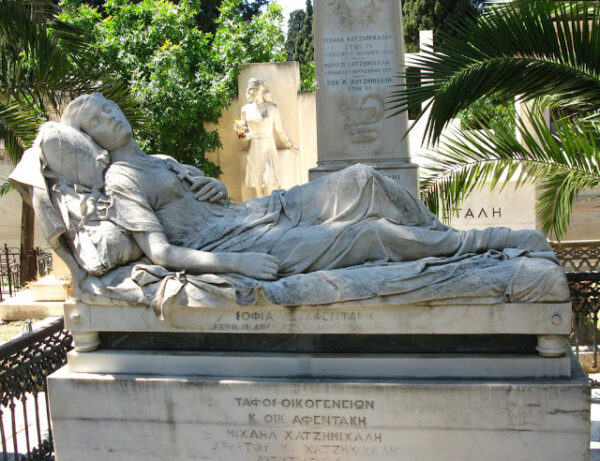
The First Cemetery Tomb of Sofia Afentaki photo Tilemahos Efthimiades
The first Cemetery of Athens, which opened in 1847, is Greece’s answer to the famous Père Lachaise Cemetery of Paris.
The cemetery is located behind the Temple of Olympian Zeus and the Panathinaiko Stadium, at the top of Anapaphseos Street (The Street of Eternal Rest).
The First cemetery of Athens is the final resting place of poets, painters and politicians.
The most famous memorial here is the tomb of Sofia Afentaki, niece of the philanthropist, and benefactor of The Afentaki Foundation, who commissioned Sculptor Yiannoulis Halepas to create the hauntingly beautiful ‘Sleeping Maiden’ for poor Sofia’s tomb, who died in 1873 at the tender age of eighteen from tuberculosis.
13. The Gestapo Interrogation Memorial:
Athens
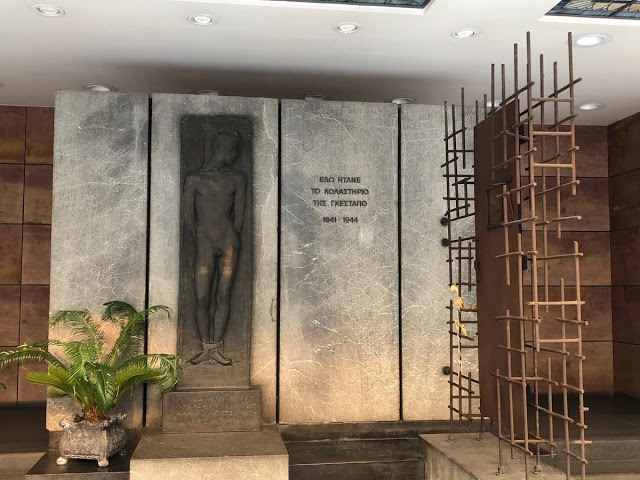
Gestapo Interagation Memorial Athens Photo gus619USA for Atlas Obscura
Surely a place straight out of Dante’s Inferno, this building, at 6 Merlin Street, Athens, was taken over by the German Nazis, during the occupation of Greece in 1941 and used as a prison for many members of The Greek Resistance of WWII.
Here, in this truly living hell, Greek prisoners were tortured to death and their bodies left hanging from trees, guarded by local Nazi sympathisers, as a warning to all Greeks.
In the 1980s the building became a Hondos Centre, one of a chain of beauty retailers in Greece.
On the right of the main entrance to the Hondos centre, is a carving of a bound prisoner, and one of the original torture chamber doors is on display.
There are several plaques, one of which reads ‘Free people were led through these doors’.
Abandoned Spaces
14. Kallio – The Sunken Village of Fokida:
Central Greece
-e1646205175321.jpg)
Kallio Sunken Village Photo Copyright Danos kounenis (danos)
The Morno Dam, an artificial lake, was constructed between 1969 and 1981, to help rectify the growing water shortage of Athens; water from the Morno River was transported to Athens via the Morno Aqueduct, at a hundred and ninety two kilometers long, the largest aqueduct in Europe.
In order to construct the Mornos dam, the typically Greek stone-built village of Kallio was evacuated; the inhabitants were compensated and rebuilt their village at a higher location.
During dry spells, and droughts, the water level of the dam falls, revealing ghostly images of the abandoned village of Kallio.
15. Vatheia – the Abandoned towers of Mani:
Peloponnese
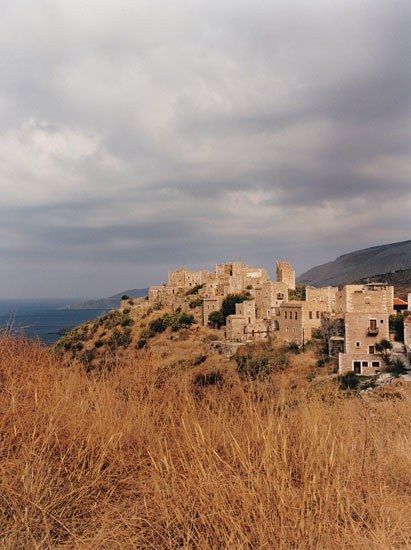
Vatheia Mani Peloponnese Greece Photo Condé Nast Traveler
Vatheia, on the Mani Peninsula of the Peloponnese, is said to be one of the most photographed places of Greece, square, stone towers, built on the rocky, infertile land of Mani, high above the sea, date back to the eighteenth century.
The Mani towers were built on high ground, not only to protect the inhabitants from their fierce, tough, warring neighbours, but as protection from their own families, family feuds were rife!
Maniates, the name given to inhabitants of the Mani area are well known as being tough, hot-headed and wild; they are also among the most hospitable of the Greeks.
After 1980, (Vatheia had no electricity up until then), an unsuccessful attempt was made to turn the place into a tourist spot, with hotel, shops and tavernas.
16. Spinalonga and Lovokomeio – Deserted Leper Colonies:
Crete and Chios

Spinalonga Leper Colony – Crete – Greece
Spinalonga, today a popular tourist attraction, is a deserted leper colony, located on a small island in the Gulf of Mirabello, Crete, officially known as Kalydon, Spinalonga became famous worldwide with the publication of Victoria Hislop’s book ‘The Island’.
This barren, rocky island was used as a leper colony from 1903 until 1957.
Any Greek diagnosed with Leprosy, known as Hansen’s disease, was relieved of his property, financial assets, his citizen’s rights and had is identity erased before being exiled to the ‘leper island’, as it came to be known as.
At its peak, Spinalonga housed around four hundred patients, who, on arriving on the island, passed through the tunnel entrance, known as Dante’s Gate, the entrance to hell.
Even though a cure for Hansen’s disease was found in 1940, only after a British ex-pat visited the colony and filed a report about the inhuman conditions, poor medical treatment, and the incompetence of the one and only doctor there, did the Greek state close the colony in 1957.
The last inhabitant to leave the island in 1962 was the priest.
Not surprisingly, the Greek government tried to keep quiet about the country’s shameful treatment towards the inhabitants of Spinalonga, Victoria Hislop’s book put paid to that!
The Lovokomeio leper colony of Chios

The Lovokomeio of Chios (The Leper Colony)
Another leper colony, Lovokomeio of Chios, one of the first in Europe, built in the fourteenth century, and opened in 1378, is virtually unknown to anyone outside of the island.
It has a history similar, if not the same, as the leper colony of Spinalonga, the Lovokomeio leper colony was mostly destroyed by earthquake, in which over eight hundred were killed, it was restored in the eighteenth century and closed in 1957.
Until someone decides to write a book about Lovokomeio, it will remain unknown and forgotten.
17. The Old Madrasa of Athens

Old Madrasa of Athens – Photo – Basilis Mathiodakis
The door is all that remains of the Islam Mandrasa (Theological school), a rectangular building consisting of living quarters, class rooms and prayer areas, which was Built in 1721.
After moving to another location, the building was converted into a filthy, overcrowded prison.
A large plane tree in the courtyard, once a meeting place for the Muslim community, which became a symbol of the Madrasa, was now used for hanging prisoners.
Those not executed in the courtyard, suffered terrible torture.
Having been partly demolished during the Greek war of Independence, the Madrasa was rebuilt as a garrison for the Greek army, who, at the end of the war, again, converted it into a prison for Greek and Turkish political prisoners and the plane tree was once again used to hang prisoners.
The prison closed at the end of the nineteenth century.
Archaeologists, hoping to find interesting, valuable artifacts beneath the site, demolished the Madrasa and by 1915 only the door remained as a memory to the unspeakable goings on of The Old Madrasa.
The door is to be found in the Plaka area of Athens, outside the Roman Agora, opposite The Tower of the Winds.
18. Yaros (Gyaros) and Makronissos:
The Secret Prison Islands

Yaros Prison – Yaros – Photo TERRABOOK
Yaros is a tiny, unpopulated Greek island of the Cyclades, close to the islands of Tinos and Andros.
The island was used during Roman times as a place of exile and from 1948 to 1974, as a prison for leftist and communist dissidents of Greece (including women).
During that time more than twenty two thousand were subjected to horrendous torture, forced labour and inhuman living conditions.
The prison block, which held over ten thousand men, was built by the inmates, many of whom were members of the Greek resistance, involved in the Greek civil War (1945-1949) and in the seven-year dictatorship (1967-1974), Jehovah’s Witnesses were also held there.
In 1952, The International Community and the United Nations, owing to the barbaric conditions, demanded all prisoners be transferred to mainland prisons.
In 1967, reporters from the German news magazine, Stern, flew over the island, taking photographs which were published all over the World, later, reporters from the French magazine, Paris Match, would do the same.
These photographs, published by two of Europe’s most prestigious magazines, played a huge role in the exclusion of Greece from The Council of Europe for abuse of human rights.
Since 2011, the island has been a NATURA protected area, building is prohibited.
The island has the largest colony of Monk seals in The Mediterranean.
The island is off limits to the public.
Makronnisos Prison Island

Makronissos Island, used as a military prison island in the mid-20th century.
Makronnissos is a small island in The Aegean Sea, close to the coast of Attica, opposite the Port of Lavrio and from the 1940s, up until the 1970s, was the site of a political prison.
Inmates of the prison included communist and leftist dissidents during the Greek Civil War (1945-1949), and the military dictatorship (1967-1974).
Composer, Mikis Theodorakis, film director, Pantelis Voulgaris and poet Giannis Ritsos, are only a few of the famous Greeks who were imprisoned there.
In 1946, the then Greek Prime Minister, Sofoulis, ordered all communists of draft age to be exiled to Makronissos, to be ‘rehabilitated’, torture, living in tents in extreme weather conditions, hunger, thirst and solitary confinement were the order of the day.
The island, which features in Victoria Hislop’s best seller: “Those Who are Loved”, was declared an archaeological site by a unanimous decision of the Central Archaeological Council in 2019.
19. Mount Parnitha Sanatorium

Mount Parnitha Sanitorium Athens Greece
Only two kilometers away from the well-known casino of Mount Parnitha, Attica, stands the forsaken sanatorium of Parnitha, built there, owing to the dry climate, for the treatment of tuberculosis, in 1912.
After the discovery and eventual use of the T.B vaccine in 1921, the sanatorium, no longer needed for T.B patients, was bought by the Hellenic Tourist Organization in around 1965.
The sanatorium was converted into one of the Xenia Hotels, a chain of hotels owned and run by the Greek government, and later became a school for tourism.
The project was eventually ditched in 1983, when it became clear they were no match for the nearby casino complex.
After the Mount Parnitha fires of 2007, the building, used mostly now by drug addicts, stands on burnt ground, there are suggestions of satanic rituals, ghostly voices, and paranormal shenanigans.
Across the road from the abandoned sanatorium of Parnitha, artist, Spyridon Dassidis, has created ‘The Park of Souls’.

The Parnitha Sanatorium and the Park of the Souls created by artist, Spyridon Dassidis
Disturbed figures, carved from burnt tree trunks, are dedicated to the memory of those who died in the sanatorium (50% of the patients were said to have died in the first five years).
20. The Dragon Houses of Karystos:
Evia (Euboea)
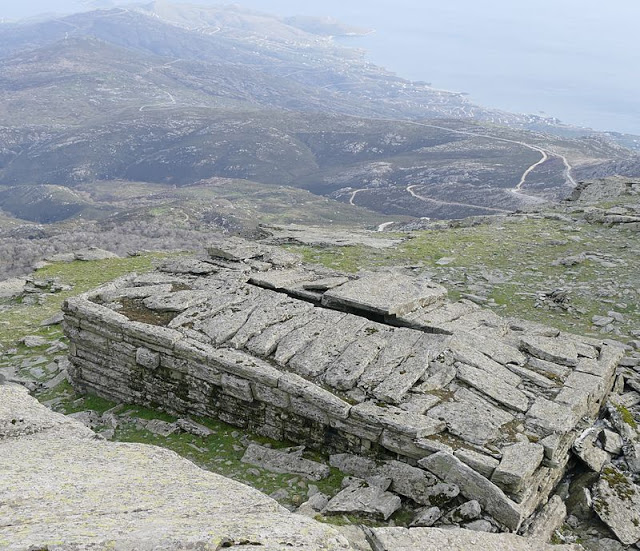
Dragon house -Karystos, Evia – Photo by Klaus-Norbert
In the south of the island of Evia (Euboea), in the town of Karystos, are twenty eight, unique structures; huge blocks of stone, with no use of mortar, are piled one on top of the other and are topped off by an even larger stone slab to create a roof.
These unusual structures were named ‘Dragon Houses’ by the ancient Greeks, as way back then, the word dragon, not only meant fire-breathing reptiles but also other beings with superhuman powers.
Many archaeologists, who have visited these mysterious structures, have failed to come up with a valid date of when they were built, or who built them.
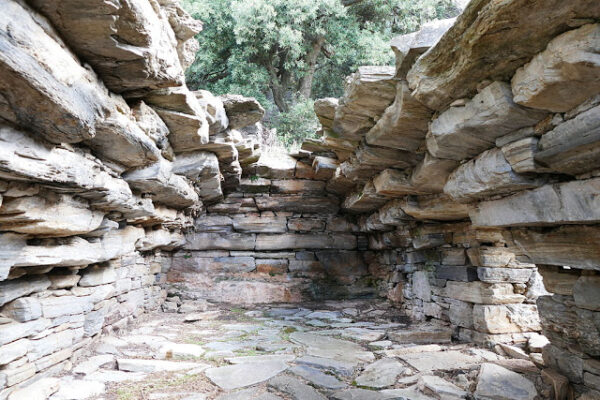
Dragon-House Palli-Lakka building Photo Klaus-Norbert Wikipedia
The Dragon Houses are thought to have originated around the seventh century BC but there was no mention of them anywhere (not even in ancient literature), until 1718, when British geologist, John Hawkins, wrote the first written account of The Dragon Houses.
Details found in a 2004 account, by researchers from the department of astrophysics, Athens University, have the structures as being oriented to the mysterious Sirius star system.
Natural or Supernatural Phenomena
21. The Petrified Forest of Lesvos

The petrified forest of Lesbos was formed when a volcano exploded in the north of the Island, covering the area with lava and ash.
In the UNESCO Geopark, designated as a protected natural monument, are four sites, located in the area enclosed by the villages of Sigri, Eresso and Antissa on the Western side of the island, containing the second largest petrified forests in the World, the largest is in Arizona.
Here at the Lesvos Geopark, are amazing specimens, not only of petrified tree trunks, including one with the thickest circumference of a petrified tree in the World, 13.7 meters, and one of the tallest at 7.2 meters, but also petrified plants, fruit and seeds, remnants of a sub-tropical forest.

Petrified tree up to 20 million years old found intact with roots and branches in Lesbos, Greece after being petrified by a volcanic eruption
The Petrified Forest of Lesvos was created over twenty million years ago, through volcanic activity when lava and ash covered the area, petrified tree trunks can even be seen in the sea, submerged to up to thirty meters.
The museum at the site, next to the Sigri Park, is a wonderful and interesting place to visit, open Monday-Sunday 8.30 to 19.00 in summer and Monday-Friday 8.30 to 16.30 in winter.

Natural History Museum of the Petrified Forest at Sigri of Lesvos. Photo Tetragon
22. The Volcanic Rocks of Lemnos

Vocanic Rocks of Lemnos Photo Kristo Pantera
Lemnos (or Limnos) is an island in The Northern Aegean, located between the islands of Lesvos and Thassos.
It is not surprising, that Greek mythology states the island to have been sacred to Hephaestus, god of metallurgy and blacksmiths, and is where his forge was said to be located, as Lemnos has a very fiery past!
Volcanic activitny, more than 20 million years ago, caused hot lava to spew over parts of the island, creating a rather alien landscape, fabulous examples of this are the volcanic rocks at Faraklo beach.
23. The Moving Rock of Kefalonia
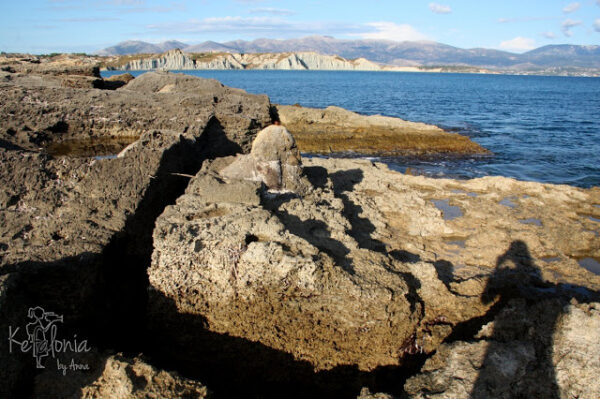
Moving Rock Kefalonia
On the island of Kefalonia, in the Ionian Sea, at Lixouri, is the beach of the moving rock, (in Greek Kounopetra).
The moving rock, or ‘kounopetra’, a huge, flat rock, with a circumference of about twenty meters, one of the landmarks of the island, is a geological mystery.
Until the devastating earthquake of 1953, the rock was unstoppable, it moved slowly, rhythmically, and continuously, twenty times a minute, from East to West.
The movement could be seen from the coast and when one is actually on the rock, vibrations can be heard.
In 1867, the rock was extremely close to shore but gradually moved further away until coming to a complete standstill after the earthquake.
Many scientists have visited the rock but no one has come up with an explanation for this strange phenomena.
24. The Church of Agia Theodora of Vasta.
Arcadia, Peloponnese.
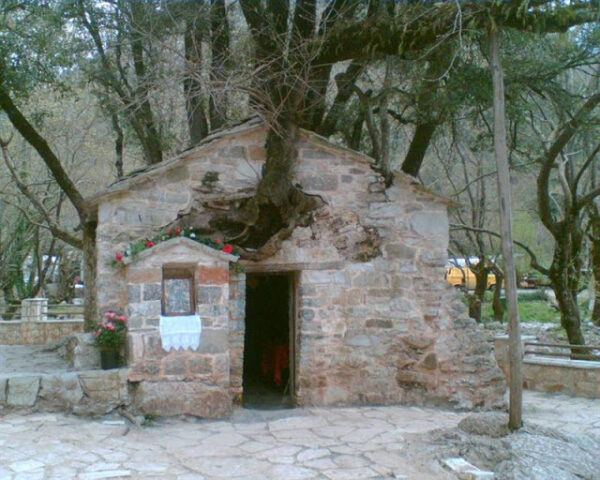
Agia Theodora Arcadia Peloponnese
Known as ‘The Miracle Church’, Agia Theodora of Vasta, in the Arcadia region of The Peloponnese, one of the most unique churches in Greece, is a small Byzantine church, which, incredibly, has seventeen holly and maple trees, most of which are over thirty meters tall, growing from its roof!
Only one thin root, about the thickness of an arm, is visible at the entrance to the church, once inside the church, no roots at all are visible.

Agia Theodora Arcadia Peloponnese
The local legend: Version one
Coming from a family of only girls, Theodora, to save her father from having to join the army, disguised herself as a boy, and joined up.
Not long after joining the army, a local girl, believing Theodora to be a boy, fell in love with her, and when Theodora, for obvious reasons, rejected her, the girl, out of revenge, claimed she was pregnant by Theodora and demanded they be married.
For reasons known only to Theodora, she did not reveal her secret, which could have saved her, and refused to marry and was consequently put to death.
The local legend: Version two
Version two is more or less the same, only this time, Theodora, again disguised as a boy, joined a monastery as a monk, why she did not save herself trouble and join a nun’s monastery is not known.
Anyway, a nun from a nearby monastery fell in love with the monk Theodora, the ending is the same.
Before her execution, Theodora prayed;
“Let my body become a church, my blood a river, and my hair the trees.”
On the very spot where Theodora was executed, a spring gushed forth and grew to become a river which still exists today, as the river which flows beneath the tiny church.
Quirky and Unexpected
25. The Fairytale Castle of Agrilis
Messina
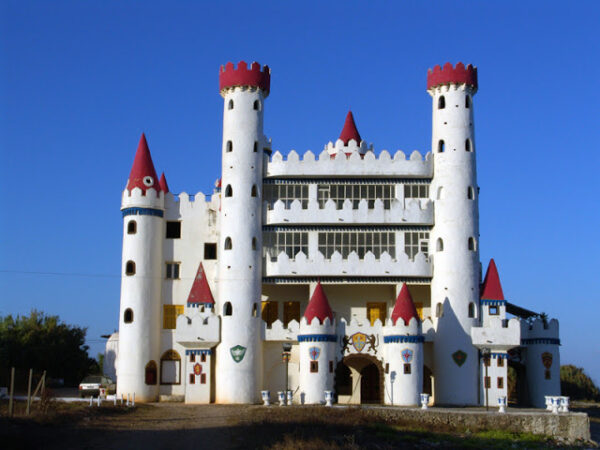
Fairytale Castle of Agrilis Photo george_iapetos George Alexopoulos
In the 1960s, American-born Harry Founier or, Founarakis, a successful surgeon from Chicago, on retirement, returned to Greece, the country of his ancestors.
In his family’s seaside village of Agrilis, in the Messina region of The Peloponnese, Harry astonished the locals by building the most unexpected dwelling, a veritable Disneyland castle, complete with drawbridge and coats of arms.
The residence has all the trimmings of a medieval castle, a large gatehouse, red-topped conical towers and inside, swords and murals, telling medieval stories, adorn the walls.
In the courtyard are three huge statues, one, the sea God Poseidon, one, the Goddess Athena and a large, white, kneeling horse.
The Fairytale Castle of Agrilis Messina
A plaque on the wall reads;
‘You should appreciate a man not by his fortune or the extent of his knowledge, but by the happiness he brings to those around him’.
26. Pittaki Street:
Psirri, Athens

Pittaki Little Kook Cafe in Halloween mode – Psirri Athens Photo by Gogo Panagiotidi Garoufali
Back in 2012, Pittaki Street, in the run-down Psirri area of Athens, was a dark, uninviting alleyway, and an alley which you would rather not enter.
With the help of a non-profit organisation, ‘Imagine the City’, and the creative design studio; ‘Beforelight’, not only Pittaki Street but the whole Psirri area was transformed into the trendy, place to be seen, that it is today.
Locals donated old lamp shades and light fittings which were refurbished and water proofed, before being hung across Pittaki street, giving it a rather permanent Christmas feel.
Alternative, quirky bars and cafes sprung up, The Little Kook Café, at the end of Pittaki Street, being the quirkiest of them all!
Psirri is now the most amazing, unique place in all of Athens, the place to see and be seen!
27. Agia Dynami Church
Athens

Agia Dynami Athens Photo by gus619USA
Agia Dynami, the Church of holy Power, is located at the corner of Mitropoleos Street and Pentelis Street, Athens.
It is a tiny, Byzantine Church; an inscription discovered there, shows that it may have been dedicated to Heracles.
During redevelopment of the city of Athens during the 1950s, the Greek Orthodox Church refused to give up the land to the Greek government, so, what could they do?
Ever resourceful, and ones never to give up, the Greeks built around the church!
28. The Roman Tomb in the Central Zara Store
Athens

zara Roman tombs in Zara store photo by Camille Gazeau
Well, this is definitely not what you expect to come across while picking out that perfect little black dress.
In the basement of the Zara store on Stadiou Street, central Athens, right next to children’s wear, protected from customers by a glass screen, is a Roman tomb, yes, you read that correctly!
The nineteenth century building, home of Ioannis Hadjikyriakos, a wealthy philanthropist, added a clause to his will, stating that the building, upon his death should pass to the state, and should become a hotel, which is what happened.
The hotel, named Hotel d’Egypt, was not a success, so it was thought maybe a name change would do the trick, and it was changed to Hotel d’ Athens, the trick did not work.
After being used, first as a Greek army headquarters, and then, during WWII, by the Germans, the building was left vacant until 2004, when the Olympic Games were held in Greece.
Modernisation and renovation of the nearby Athens Metro revealed an ancient Roman tomb, right in front of the Hadjikyriakos building.
Strict Archaeological laws meant the tomb stayed where it was, which is how the tomb comes to be in the basement of Zara’s.
Well, if that’s not a magnet to attract customers, I don’t know what is!
29. The Andreas Syggrou Wax Museum
Athens
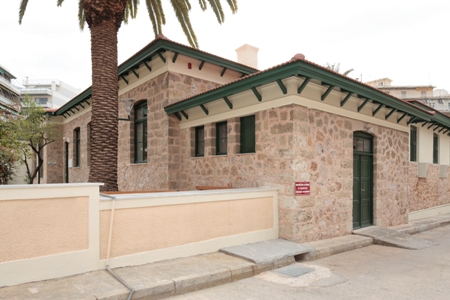
The Andreas Syggrou Wax Museum Athens
The Andreas Syggrou wax Museum is a little-known, extraordinary museum, located in the grounds of the Andreas Syggrou Hospital of Venereal and Dermatological Diseases, located behind the Athens Hilton, at 5 Dragoumi Street, near to the Evangelismos Metro Station.
Andreas Syggrou (1830-1899) was a philanthropist and a Greek banker from Istanbul, who, after moving to Greece became the founder and benefactor of many banks, the building of an avenue from the Royal Palace, the bay at Palaio Faliro and much more, he was also responsible for the completion the Corinth Canal.
Glass show cases display hundreds of grotesque body parts afflicted with various skin and venereal diseases.
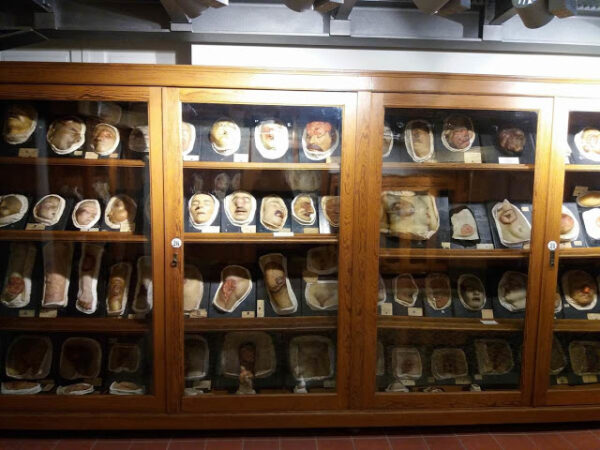
Wax Andreas Syggros Wax Museum Athens Photo by Aika for Atlas Obscura
It is the largest collection of its sort in the world, composing of over sixteen thousand body parts, limbs, faces and even whole bodies.
The museum opened as an educational department in 1913, the body parts are copies of actual symptoms seen on patients between 1913 and 1958.
Today, the totally renovated museum is used to train doctors, and the museum is open every day and is free of charge.
30. The Political Exile Museum of Athens
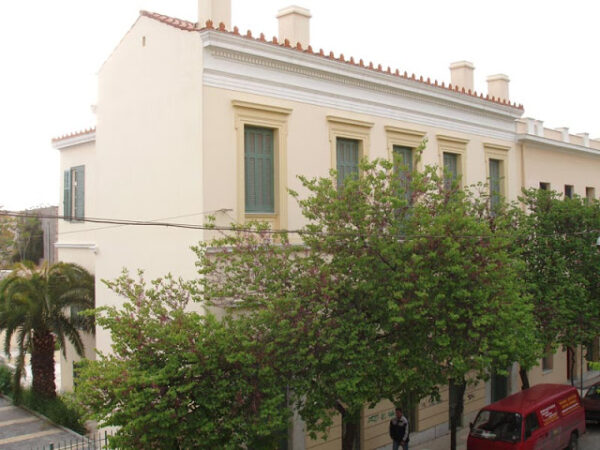
Exile Museum Ai Stratis Athens Photo www.exile-museum.gr
Tucked away at number 1 Asomaton Street, in the Thissio-Kerameikos area of Athens, next door to each other, are two, small, sad, museums.
The Exile Museum of Ai Stratis, and the Exile Museum of Makronissos.
Ai Stratis (Agios Efstratios) is a small Greek island in the northern Aegean Sea, an island where over a hundred thousand men, women and children were exiled between 1926 and 1967.
Makronissos, another small island in the Aegean Sea, was also the site of a political prison from the 1940s to the 1970s, located close to the coast of Attica, facing the port of Lavrio.
Displayed in the museums are heartbreaking exhibits, newspaper articles and stories about the mass exile of people the Greek government considered to be undesirables.
Dare you visit?
The above mentioned places are not everyone’s cup of tea, nor are they on everyone’s to-see list, and some of these places, in my opinion, could be classed as ‘Dark Tourism’.
As sad and disturbing as many of these places are, they should not be forgotten, in the hope that remembering, will go a long way to prevent similar atrocities ever happening again.



